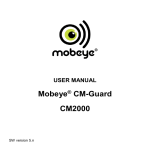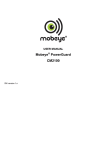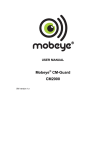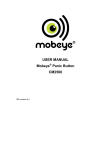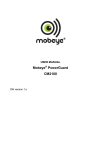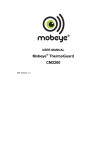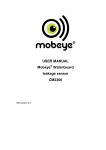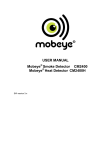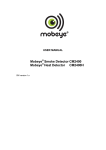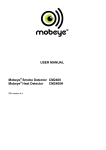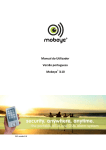Download CM2300 Mobeye WaterGuard (float sensor) (3.n)
Transcript
USER MANUAL Mobeye® WaterGuard float sensor CM2300FS SW version 3.n Attention! Very important This user manual contains important guidelines for the installation and usage of the Mobeye ® device as described in this manual. Please read these thoroughly before you start using the Mobeye® device! In case of damage caused by disregarding the guidelines, the warranty becomes void. The user must regularly check the proper functioning of the device. The manufacturer cannot be held liable for any damage or loss caused by any incorrect use or incorrect functioning of the Mobeye® device. Safety guidelines • The permitted ambient temperature during operation may not be exceeded (not lower than -10°C and not higher than 50°C). • The device is intended for use in dry and clean places. • Protect the device from moisture, heat and water splashing. Not intended for external use. • The guidelines for the battery usage must be regarded. • Do not expose the device to strong vibrations. • Do not let it fall from height. • Do not use in an environment where any inflammable gases, vapors or dust are present or could be present. • Repair of the device may only be carried out by people, trained for Mobeye® repair. • If the device must be repaired, only original replacement components may be used. The use of different parts may lead to damage of the Mobeye® device. Use in accordance with the regulations The purpose of this device in accordance with the regulations is sending SMS text messages and making telephone calls after an alarm situation. Other uses are not permitted and may invalidate the warranty. Battery recycling CR123 batteries, as used in the Mobeye WaterGuard, are classified as non-hazardous waste and can be recycled. Please take empty batteries to a nearest collection point. CONTENT 1. General description 1 2.1 2.2 2.3 2.4 2.5 2.6 Getting started Insert a SIM card Connect a sensor to the input Insert the batteries Enter the program mode Program at least one telephone number Switching on/off 2 2 2 2 2 3 3 3.1 3.2 Use of input 2 and external power supply Using input 2 Use of external power supply 4 4 4 4.1 4.2 4.3 4.4 Configuration Program mode The (security) code Programming the settings by SMS List of SMS commands for configuration 5 5 5 5 6 5.1 5.2 5.3 5.4 5.5 5.6 5.7 5.8 5.9 5.10 5.11 5.12 5.13 5.14 Possible settings Phone numbers Identification text Alarm texts SMS on/off Call on/off Input type Exit delay time Alarm delay time Inactive time Alarm repeat time Power failure delay time Power failure message Test message System reset 7 7 7 7 7 7 8 8 8 8 8 9 9 9 9 2. 3. 4. 5. 6. Request list of the settings and status 10 7. Technical messages and status feedback 11 1. GENERAL DESCRIPTION The Mobeye WaterGuard is a battery operated GSM module used to send out an alarm after detection of a water based fluid, after a triggered input or - if external power supply is used- after a power failure. The Mobeye WaterGuard is pre-programmed with standard action-reaction patterns. To change this behaviour please refer to chapter 4. The factory settings of the Mobeye WaterGuard cause following reactions: - If the water sensor is closed, the Mobeye WaterGuard sends an alarm SMS text message and calls to the phone numbers as programmed. The SMS message contains the text ‘Mobeye Water alarm’. - As soon as no water is detected anymore, an SMS text message is sent to the set telephone numbers containing the text ‘Mobeye Water Level OK’. - If the additional input is activated by a sensor, the Mobeye WaterGuard sends an alarm SMS text message and calls to the phone numbers as programmed by the user. - If the water sensor and/or the input remain in the alarm status, the Mobeye WaterGuard repeats sending the SMS alarm message every four hours. - When the batteries need to be replaced, the Mobeye WaterGuard sends a ‘battery low’ SMS text message to the administrator. - In case an external power supply is used and a power failure occurs, the Mobeye WaterGuard sends a ‘power failure’ SMS text message to the administrator. When the power is restored, the Mobeye WaterGuard sends a ‘power restored’ SMS text message to the administrator. 1 2. GETTING STARTED To get started with the Mobeye WaterGuard at least the following steps need to be taken in the following order: 1. Insert a SIM card 2. Connect the water sensor to the input 3. Insert the batteries 4. Enter the program mode 5. Program at least one telephone number (administrators’ number) 6. Arming/disarming the system These steps are further explained in this chapter. After these steps the module will be operational. 2.1 INSERT A SIM CARD Open the enclosure with the 4 screws and insert a SIM card into the module. Push the black cover outward slightly to open the holder. Before installing the SIM card should have PIN code "0000", or PIN code removed. (A PIN code can be changed or removed by putting the SIM card in to any mobile phone and entering the 'security' menu) NB: Make sure the SIM card is inserted before the batteries are inserted. In case of a SIM card change, please first remove the batteries (and remove any other external power supply). 2.2 CONNECT A SENSOR TO THE INPUT Insert the 2 wires of the external float sensor through the hole of the enclosure to the inside part and next in the two connectors of input 1 (press on the green pins for connecting the wires). It does not matter which wire is connected to which connector. If necessary the wires can be extended up to 5 meters using appropriate wire material. Mount the floater to a fixed place in horizontal position with the moving part in open status. Mount the sensor at the height where the presence of water should be detected. In case the floater should be closed in normal situation (and be opened after water detection), the input type should be changed (please refer to paragraph 5.4). 2.3 INSERT THE BATTERIES Insert the two batteries (CR123) in the module. Use the +/- indication for the correct placement. The green LED will flash to indicate that the module is not configured (at least one telephone number should be programmed). 2.4 ENTER THE PROGRAM MODE Directly after inserting the batteries, the Mobeye WaterGuard switches to the program mode. First the GSM module establishes network connection. During this time the LED flashes 2 sec. on/1 sec. off. Within 10-30 seconds the connection is established and the status LED starts flashing 1 sec. on/1 sec. off (or stays on continuously in case the first telephone number has been configured). The Mobeye WaterGuard returns to the program mode by pressing the on/off button for 5 seconds, until the LED starts flashing (or stays on continuously). As long as the unit is in the program mode, the status green LED is on (or flashing 1 sec. on/1 sec. off if the module has no configuration). During the first 3 minutes, the GSM module remains active, ready to receive SMS commands. After 3 minutes a time-out occurs and the GSM module switches off in order to save the batteries. The unit returns to the low power operational mode. 2 2.5 PROGRAM AT LEAST ONE TELEPHONE NUMBER The Mobeye WaterGuard is able to send messages up to 5 telephone numbers. The first telephone number belongs to the administrator. Technical messages (like battery low) are sent to the administrator only. Without the administrators’ phone number, the Mobeye WaterGuard cannot function. When the WaterGuard is in initial (factory) status and the batteries are inserted (so the LED is flashing), the administrators’ number is programmed by calling the telephone number of the Mobeye WaterGuard using the administrators’ phone. The unit will recognize this number and store it as administrator (telephone number 1). The administrator will receive a confirmation SMS text message including the security code. This code is needed to program the other settings in the unit. NB: For this way of programming the number recognition in the administrator’s phone must be ‘on’. To program or change the administrators’ number by SMS command, please refer to 4.2. 2.6 SWITCHING ON/OFF After the previous steps, the Mobeye WaterGuard is ready for use. It is armed (switched on) automatically. The green LED blinks once every 3 seconds. In order to switch off (disarm) the Mobeye WaterGuard: - Press the on/ off button at the upper side for 1 second. The green LED switches off to indicate the disarmed status. In order to switch on (arm) the Mobeye WaterGuard: - Press the on/ off button at the upper side for 1 second. The green LED blinks once every 3 seconds (or stays on continuously in case of an external power supply) to indicate the armed status. 3 3. USE OF INPUT 2 AND EXTERNAL POWER SUPPLY 3.1 USING INPUT 2 It is possible to connect an external sensor to input 2. As a standard reaction after a triggered input, the Mobeye WaterGuard sends an SMS text message to the preset numbers and calls these numbers. Insert the 2 wires of an external sensor through the hole of the enclosure to the inside part and next in the two connectors of input 1 (press on the green pins for connecting the wires). It does not matter which wire is connected to which connector. If necessary the wires can be extended up to 5 meters using appropriate wire material. As default the inputs are programmed as Normally Open (NO) contacts. This means the inputs are triggered if the input is closed for at least 1 second. In case the contact is Normally Closed (NC), please refer to paragraph 5.6. If you require the sensor to be activated for a shorter or longer period before triggering an alarm, please refer to 5.8. 3.2 USE OF EXTERNAL POWER SUPPLY Although the Mobeye WaterGuard is designed to run on batteries, it is possible to use an external power supply. In this mode the module is always in connection with the GSM network and therefore always in program mode. In case the power fails, the batteries take over the functioning and the administrator is informed by an SMS text message. The module continues operating albeit in the low power mode. This means the GSM module switches off and only establishes network connection in case it needs to send out an alarm, test message or low battery alert. Connect the external power adapter (or any other regulated 12VDC power supply) to the power input of the connector (press on the green pins for connecting the wires): - V+ (black lead with white stripe) to “+” - Ground (black lead) to “-“ 4 4. CONFIGURATION To program the Mobeye WaterGuard, the GSM module must have network connection. In case only batteries are used, first switch the unit to the program mode. Next send SMS commands for the configuration. All settings are stored and will be kept in the unit, even in case the power supplies are removed. 4.1 PROGRAM MODE Directly after inserting the batteries, the Mobeye WaterGuard switches to the program mode. First the GSM module establishes network connection. During this time the LED flashes 2 sec. on/1 sec. off. Normally this takes 10-30 seconds. Once the connection is established the status LED starts flashing 1 sec. on/1 sec. off (or stays on continuously in case the first telephone number has been configured). In program mode, the device is ready to receive SMS commands. If no correct command is received for 3 minutes, the GSM module switches off in order to save the batteries. The unit returns to the low power operational mode. The Mobeye WaterGuard returns to the program mode by pressing the on/off button for 5 seconds, until the LED starts flashing (or stays on continuously). If the unit is connected to an external power supply, the WaterGuard has network connection all the time and the unit is in program mode all the time. The program mode is interrupted by pressing the on/off button for one second until the LED switches off. The unit is switched off completely (disarmed). 4.2 THE (SECURITY) CODE For configuration activities the (security) code of the Mobeye WaterGuard must be used. The initial (security) code is ‘1111’. You can change the (security) code to your own code. See section 4.4. 4.3 PROGRAMMING THE SETTINGS BY SMS To program the settings by SMS text message: 1. Be sure the WaterGuard is in program mode (please refer to 4.1). 2. Send an SMS message with the (security) code and the command 3. The green LED blinks 3 times to indicate the successful configuration. In case of an incorrect command, the red LED flashes 5 times. SMS messages should have the following content: CODE COMMAND:OPTION - Do not forget the space character between (security) code and command. - The commands are case sensitive. Use capitals for the commands. - Several commands may be combined in one SMS message (with a maximum of 160 characters) by placing a # between the commands. CODE COMMAND:OPTION#COMMAND:OPTION#COMMAND:OPTION See section 4.4 for a full list of SMS commands. 5 4.4 LIST OF SMS COMMANDS FOR CONFIGURATION The setting options for the WaterGuard. Setting SMS Command Change security code INSTCODE: Set telephone number for alarm TEL1: …. messages TEL5: Delete telephone number DEL1 Options 0000..9999 Default value 1111 Empty Identification text DEL5 NAME: 20 characters Mobeye Call on/off SMS on/off Input type input 1 Input type input 2 Delay on input 1 Delay on input 2 Inactive time input 1 Inactive time input 2 Alarm repeat time Alarm text water alarm Alarm text water alarm restore CALL: SMS: TYPEIN1: TYPEIN2: DELAY1: DELAY2: INACTIVEIN1: INACTIVEIN2: REPEAT: TEXT1: TEXT2: ON, OFF ON, OFF NO, NC NO, NC 0..999 (sec) 0..999 (sec) 0..60 (min) 0..60 (min) 0..24 (hrs) 20 characters 20 characters ON ON NO NO 1 1 0 0 4 Water alarm Water level OK Alarm text input 2 Power failure delay time Power message Interval ‘test SMS’ TEXT3: DELAYPOW: POWERMESSAGE: TEST: 20 characters 0..999 (min) Alarm 2 0 ALARM 0 …. Examples: Set phone number 1 : 1111 TEL1:0712345678 Delete phone number 1: 1111 DEL1 Be aware of the space between “1111” and the command 6 OFF,ALERT,ALARM 0..30 (days) 5. POSSIBLE SETTINGS 5.1 PHONE NUMBERS The Mobeye WaterGuard is able to send alarm messages to up to 5 phone numbers. The first telephone number (TEL1) belongs to the administrator. Only this number receives all system messages. The other phone numbers (including the administrator) only get the alarm messages. To set or change telephone numbers: SMS command 1st telephone number: example: TEL1: 1111 TEL1:07123456789 .... similar for TEL2:, TEL3:,TEL4 and TEL5: For foreign number, start with + followed by the country code (and depending on the country leave out the zero for the local area code). example: 1111 TEL1:+447123456789 To delete telephone numbers: SMS command delete 1st telephone number: example: .... similar for DEL2, DEL3, DEL4 and DEL5 DEL1 1111 DEL1 5.2 IDENTIFICATION TEXT It is possible to add a standard identification text (NAME) to all messages sent out by the Mobeye WaterGuard. The alarm messages are a combination of the name and the alarm text. A user defined identification has a length of maximum 20 characters. The default identification text is ‘Mobeye’. SMS command identification text: example: NAME: 1111 NAME:my Mobeye device 5.3 ALARM TEXTS Unique alarm texts can be programmed into the Mobeye WaterGuard. User defined texts have a maximum length of 20 characters. Following default texts are programmed: Text 1 (water alarm): Water alarm Text 2 (water alarm restore): Water level OK Text 3 (input 2): Alarm 2 SMS command text water alarm: SMS command text water restore: SMS command text input 2: example: TEXT1: TEXT2: TEXT3: 1111 TEXT1:water in cellar 5.4 SMS ON/OFF By default, the Mobeye WaterGuard sends alarm notifications via text message and calls (you will hear a beep signal) to the preset contact persons. By turning off the SMS, the unit will only call after a triggered input. SMS command enable / disable SMS: example: SMS:ON or SMS:OFF 1111 SMS:OFF 5.5 CALL ON/OFF By default, the Mobeye WaterGuard sends alarm notifications via text message and calls to the preset contact persons. By turning off the CALL, the unit will only send an SMS text message as alarm notification. It is not possible to switch off both the SMS and the call. SMS command enable / disable call: example: CALL:ON or CALL:OFF 1111 CALL:ON 7 5.6 INPUT TYPE The input type defines the character of the inputs IN1 and IN2. This can be Normally Open (NO) or Normally Closed (NC). If an input is set to NO, the alarm will be triggered as soon as the terminals of the input are closed. If the input is set to NC, the alarm is triggered in case the connection between the input terminals is broken. The default input type is set to NO. SMS command input type input 1: SMS command input type input 2: example: TYPEIN1:NO or TYPEIN1:NC TYPEIN2:NO or TYPEIN2:NC 1111 TYPEIN1:NC 5.7 EXIT DELAY TIME The exit delay time defines the time between the moment of switching on the module – while the input is active – and the moment the module starts sending the first alarm message. Example: the module was installed in a cabinet where a door magnet contact is connected to the input. The exit delay time is the time between switching on the module and closing the cabinet’s door. As soon as this time has exceeded, the alarm message will be sent. The time can be set between 0 and 999 seconds. As default, the exit delay time is set to 1 second. SMS command exit delay input 1: SMS command exit delay input 2: example: DELAYEXIT1: DELAYEXIT2: 1111 DELAYEXIT2:806 5.8 ALARM DELAY TIME The input delay time defines the time that the input is triggered before an alarm is initiated. If the input returns to the non-alarm status within the delay time, no alarm is sent. The time can be set between 0 and 999 seconds. As default, the input delay time is set to 1 second. SMS command alarm delay input 1: SMS command alarm delay input 2: example: DELAY1: DELAY2: 1111 DELAY1:999 5.9 INACTIVE TIME The “inactive time” defines the time an input is not active after an activation. During the inactive time, no new alarm message will be sent. Only when the input returned to the non-alarm status, gets activated again and remains active, an alarm will be sent yet after the inactive time. If the time is set to “0” (minutes), the input is active again immediately after returning to the non-alarm status. The time can be set between 0 and 60 minutes. As default, the inactive time is set to “0”. SMS command inactive time input 1: SMS command inactive time input 2: example: INACTIVEIN1: INACTIVEIN2: 1111 INACTIVEIN2:45 5.10 ALARM REPEAT TIME In order to emphasize the urgency of the alarm messages, all alarms can be repeated. As long as the alarm status has not returned to the inactive status, the SMS alarm will be repeated after the ‘alarm repeat time’. The time can be set between 0 and 24 hours. As default the alarm repeat time is set to 4 hours. SMS command alarm repeat time: example: REPEAT: 1111 REPEAT:20 8 5.11 POWER FAILURE DELAY TIME In case the Mobeye WaterGuard is powered externally and the power fails it can notify the contact person(s). The power failure delay time defines the time that the power fails before an alarm is initiated. If the power is restored within the delay time, no alarm is sent. The time can be set between 0 and 999 minutes and is only accepted if the POWERMESSAGE is set to ‘ALARM’. As default, the delay time is set to 0. SMS command power failure delay time: example: DELAYPOW: 1111 DELAYPOW:15 5.12 POWER FAILURE MESSAGE In case the Mobeye WaterGuard is powered externally and the power fails it sends an SMS text message to the administrator (setting: ‘ALERT’). The message is only sent in case the unit is armed. This message can be set to ‘ALARM’ or ‘OFF’. If the setting is ‘ALARM’ the power failure message will be sent to all contact persons (SMS and or CALL, following the SMS on/off and CALL on/off settings). The setting ‘OFF’ means that no power failure message is sent. The default setting for the ‘power failure message’ is set to “ALERT”. SMS command power failure message: example: POWERMESSAGE:ALARM (or ALERT or OFF) 1111 POWERMESSAGE:ALARM 5.13 TEST MESSAGE The Mobeye WaterGuard can send regular test SMS messages (keep alive) to the administrator (first phone number), to ensure the proper functioning of the unit. The test message function is only active if the unit is armed. The interval between the test messages can be set between 0 days (no test message) and 30 days. The default test interval is set to 0 (no test message). SMS command interval test message: example: TEST: 1111 TEST:21 5.14 SYSTEM RESET To reset the Mobeye WaterGuard to its factory settings: 1. Remove the batteries (and external power supply) 2. Press the outside button while reinserting the batteries. Keep it pressed for (about) another 5 seconds 3. Release the button immediately after the LED starts to flash 4. If relevant, connect the external power supply. After a successful reset, the status LED on the keypad will blink green to indicate that the module is not configured. The security code is back to factory settings as well. 9 6. REQUEST LIST OF THE SETTINGS AND STATUS The programmed settings and status of the GSM detector can be retrieved by SMS message. Before sending the request, make sure the unit is in the program mode (please refer to 4.1). STATUS REQUEST The status of the Mobeye WaterGuard can be requested by sending an SMS with the content: SMS command status request: example: STATUS? 1111 STATUS? Upon sending this request, the Mobeye WaterGuard returns the status to the originator of the request. The status message includes the ARMED / NOT CONFIGURED status of the Mobeye WaterGuard, the status of the inputs, power and batteries. LIST OF GENERAL SETTINGS The general settings of the Mobeye WaterGuard can be requested by sending an SMS with the content : SMS command list general settings: example: SET? 1111 SET? LIST OF PHONE NUMBERS The list of telephone numbers can be requested by sending an SMS message with the content : SMS command list of phone numbers: example: CALL? 1111 CALL? 10 7. TECHNICAL MESSAGES AND STATUS FEEDBACK Technical messages In the event of technical issues the administrator receives an SMS message. Possible technical messages are: Message Low batteries, external power supply OK No external power supply, batteries OK Low batteries, no external power supply External power supply OK, batteries OK (delayed massage) Reason Power is available, batteries need to be replaced No external power supply, batteries are able to take over operation in low power mode No external power supply, batteries need to be replaced The external power is restored (or the adapter is plugged in a socket), batteries do not need to be replaced If (delayed message) is added to the SMS text messages, the message couldn’t be sent earlier, due to a SIM card failure or GSM network failure. When receiving one of the above mentioned technical messages, please take appropriate action as soon as possible. During the battery replacement, the SIM card does not have to be removed. Status feedback LED pattern Blinking green, 1 second on / 1 second off 1 green flash every 3 seconds Green LED stays on continuously Blinking green, 2 seconds on, 1 second off Blinking green, 3 seconds on, 1 second off 2 flashes red, every 3 seconds Status Module not configured Module is switched on, powered by batteries Module is switched on, powered by an external source Module establishes network connection to send an alarm message Module establishes network connection to get to program mode No GSM connection Required action Configure at least one telephone number No action required No action required Wait until the network connection is established and the message is sent Wait until the network connection is established before programming Try the SIM card in any mobile telephone; replace SIM card using other telecom provider; try the module at another location Try the SIM card in any mobile telephone; remove PIN code; check credit; replace SIM card 3 flashes red, every 3 seconds No valid SIM card or wrong PIN Blinking 3 times green Successful programming action Faulty programming action No action required Low batteries Replace both batteries Blinking 5 times red 4 red flashes every 3 seconds 11 Check SMS command Technical specifications GSM : Batteries Battery life in normal mode Ext. power connection : : : Power consumption low power Power consumption 12V Dimensions Ambient temperature : : : : Quad band EGSM, 850/900/1800/1900 MHz 2* CR123 (lithium) >1 year 12 VDC (+/- 2 VDC) / min. 500 mA. (optional) ca 50 μA. stand-by / max. ca. 500 mA ca 50 mA. stand-by / max. ca. 500 mA 80 x 60 x 40 mm -10 °C until +50 °C This manual is published by Mobeye®. All rights, the translation included are reserved. Any reproduction, either photocopy, microfilm or saved in an automated data dictionary, only after written approval of the Publisher. Reprinting, even in summary, is prohibited. This user manual meets the technical requirements at the moment of printing. Changes in technology and equipment are reserved. © Copyright 2014 by Mobeye, version CM2300FSEN140514 12 Declaration of Conformity Herewith we, Mobeye, declare that the product Mobeye CM21 telemetry module And the derived products CM2000, CM2100, CM2200, CM2300, CM2300FS, CM2400, CM2500, CM2600 are in compliance with the essential requirements of the following European standards / EU Directives: Directive 73/23/EEC (low voltage directive) Directive IEC/EN 50130 Electromagnetic compatibility Directive 1995/5/EC R&TTE (Radio & Telecommunications Terminal Equipment) The conformity with the essential requirements of 1995/5/EC has been verified against: ETSI EN 301 489-1 V1.5.1 ETSI EN 301 489-7 V1.2.1 ETSI EN 301 511 V9.0.2 CENELEC EN 60950:2001 Mobeye B.V., Poeldonkweg 5, 5216 JX ’s-Hertogenbosch, The Netherlands 13
















